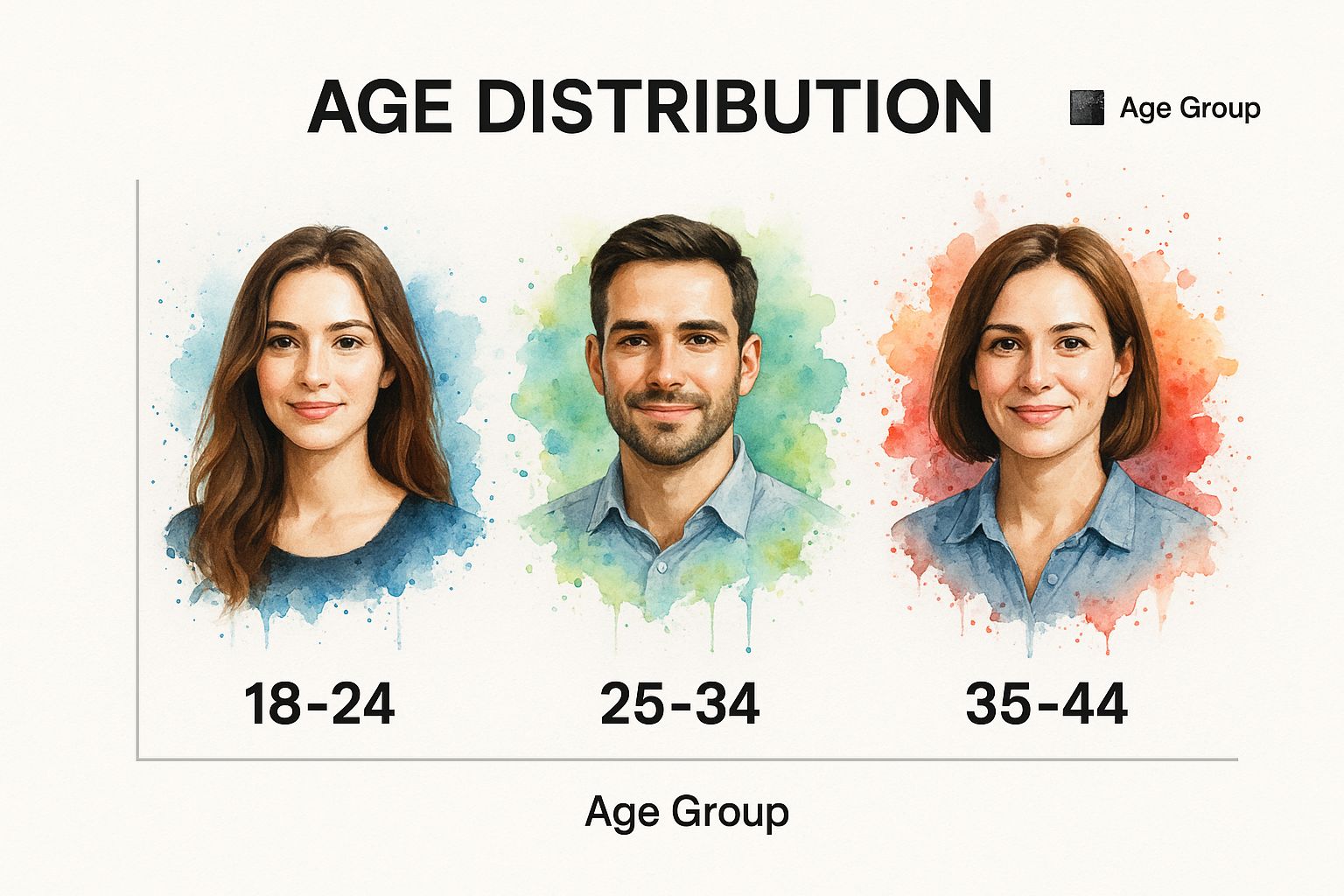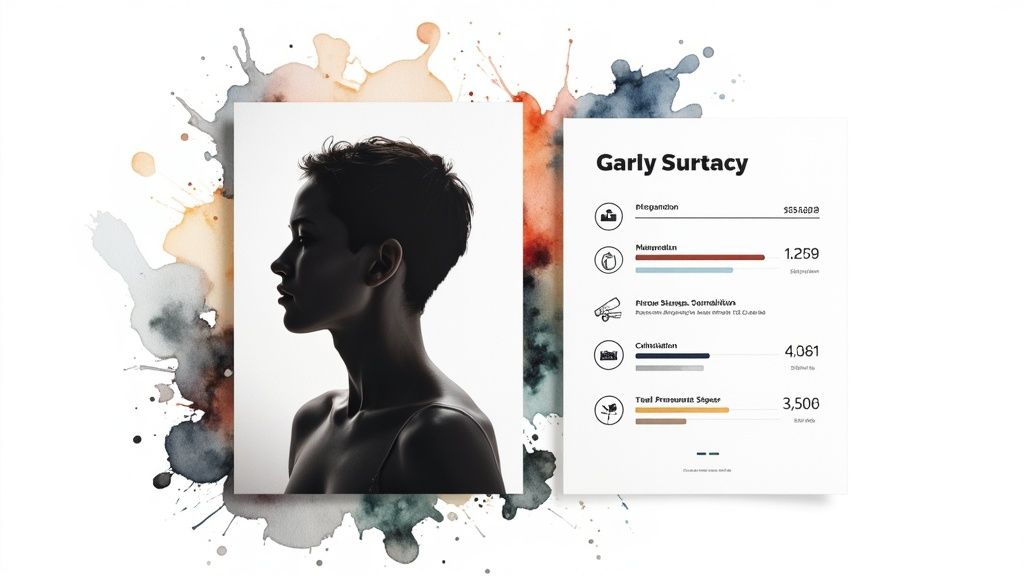Target Audience Social Media: Find & Engage Effectively

So, what does defining a target audience for social media really mean? It’s about creating a crystal-clear picture of the specific people you want to connect with. We're going way beyond basic demographics here—we're talking about their passions, their online habits, and what makes them tick. Getting this right is what makes your content truly resonate and spark actual engagement.
Figuring Out Who You’re Really Talking To
Before you can find your audience, you first have to know who they are. Great social media marketing isn't about shouting into a digital void and hoping for the best. It’s about starting a genuine conversation with people who actually care about what you have to offer. This initial work is what turns a strategy from pure guesswork into a focused, effective plan.
The journey starts by looking inward at the people already connected to your brand. Dive into your current customer lists, email subscribers, and website traffic. Look for the common threads that tie them together. But don't just stop at age and location. You need to dig much deeper to uncover their real-world goals, their biggest frustrations, and the motivations that drive their decisions.
Start with the People Who Already Love You
Your current customers are an absolute goldmine of insight. They picked you over everyone else for a reason, and figuring out that "why" is the secret to finding more people just like them. It's time to stop making assumptions and let the data build the picture for you.
Look for patterns in these areas:
- Demographics: What are the most common age ranges, locations, and job titles?
- Psychographics: What do they value? What are their hobbies and interests? Which other brands do they follow?
- Pain Points: What specific problem does your product or service solve for them?
Doing this initial homework gives you a solid, data-backed foundation. For example, a fitness app might discover its most loyal users aren't just "people wanting to lose weight." They're actually busy professionals, aged 30-45, who desperately need quick and effective workouts they can do at home. That one insight changes everything about their marketing.
Key Takeaway: Your best future customers often share a striking resemblance to your best current ones. Start your research by getting to know the people who have already put their trust in your brand.
To build a truly effective profile, you need to collect a mix of demographic and psychographic information. These details come together to create what marketers call a buyer persona—a semi-fictional character representing your ideal customer.
Here's a quick reference for the essential data points you'll want to gather.
Essential Data for Your Buyer Persona
| Data Category | What to Look For | Example |
|---|---|---|
| Demographics | Age, gender, location, income, education, occupation. | "Sarah, 32, lives in Austin, TX, works in marketing, earns $75k/year." |
| Psychographics | Interests, hobbies, values, lifestyle, personality traits. | "Loves hiking, values sustainability, early adopter of new tech." |
| Goals | What they are trying to achieve, both personally and professionally. | "Wants to improve her work-life balance and learn a new skill." |
| Challenges | The pain points and obstacles standing in their way. | "Struggles to find time for professional development, feels overwhelmed by choices." |
| Motivations | The "why" behind their goals and behaviors. | "Driven by career advancement and a desire for personal growth." |
| Online Behavior | Favorite social platforms, preferred content types, online shopping habits. | "Active on Instagram & LinkedIn, prefers video content, shops online weekly." |
This table isn't just a checklist; it's the blueprint for creating content that speaks directly to the needs and desires of your audience, making them feel seen and understood.
Ethically Spy on Your Competitors
Here's another powerful tactic: analyze who is following and engaging with your direct competitors. Think about it—their audience is a pre-vetted pool of potential customers who are already interested in your industry.
Take a look at the public profiles of their most active followers. What kind of content makes them light up the comments section? What questions are they asking? Spotting these patterns can expose market gaps or audience segments your competitors are completely missing.
This isn't about sneakily stealing their followers. It’s about understanding the broader conversation happening in your niche so you can find your unique voice. Seeing what works for others—and what doesn't—helps you sharpen your own targeting and craft messages that cut through the noise.
Choosing Where Your Audience Actually Lives Online
Figuring out who your ideal customer is? That’s just the first half of the puzzle. The real challenge is discovering where they actually spend their time online. Trying to be everywhere at once is a surefire way to burn out and see your efforts fall flat. The goal is to strategically pick the 2-3 platforms where your target audience on social media is most engaged and ready to listen.
This isn’t about jumping on the latest viral app. It's about a smart, deliberate match between a platform's culture and your buyer persona. If you’re a B2B software company trying to reach C-suite executives, your home is almost certainly LinkedIn. But if you're selling quirky, handmade jewelry, you'll probably thrive on the visual-first feeds of Instagram and Pinterest.
Match the Platform to the Persona
Every social network has its own unique vibe and user base. Before you pour time and money into creating content, you need to think about the primary purpose of each major platform. It's like picking a venue for an event—you wouldn’t book a corporate seminar in a nightclub, right?
-
LinkedIn: This is the undisputed champion of professional networking. It’s perfect for B2B companies, establishing thought leadership, and connecting with decision-makers in very specific industries. The entire culture is career-oriented, so educational and professional content performs best.
-
Instagram & Pinterest: These are visual playgrounds. They are tailor-made for brands in fashion, beauty, food, home decor, and travel. Success here is all about high-quality images, strong aesthetics, and inspiring content. Don't forget that Instagram Stories and Reels give you a powerful way to show a more authentic, behind-the-scenes look at your brand.
-
TikTok: Think short-form video, humor, and fast-moving trends. This is a space for raw creativity and entertainment, heavily dominated by Gen Z and younger millennials. Brands that can let their hair down, be playful, and move quickly on trends can see explosive growth here.
A critical part of finding your target audience on social media is understanding that you don't need to be everywhere. You just need to be where it counts. Focus your energy on building a real community on the platforms that matter most to your specific customers.
Look at the Data Behind the Platforms
To make a truly informed decision, you have to look past the stereotypes and dig into the actual user data. For example, you’ll hear people say that younger generations have completely abandoned Facebook, but the numbers paint a much more complex picture.
As of early 2024, Facebook is still the largest social platform on the planet, boasting over 3.065 billion monthly active users. Its single largest user group is 25-34 year-olds, who make up 31.1% of its audience. For many businesses, it remains a powerhouse for driving direct purchases. You can find more of this kind of data in recent social media reports to help guide your strategy.
This infographic gives you a great visual breakdown of user demographics by age, showing exactly where different generations are congregating.

The image makes it crystal clear how certain platforms cater to specific age brackets. This really drives home the point: aligning your platform choice with your persona's age demographic is non-negotiable. It ensures your message doesn't just get sent into the void, but is actually seen and heard by the right people.
Tapping into the Right Tools for Audience Discovery
Guesswork won't get you very far in social media. To really connect with your target audience on social media, you have to ditch the assumptions and get your hands on some real data. The good news? You don’t need a massive budget to do it. Many of the most powerful tools are already built into the social platforms you use every single day.
This is where your strategy moves from a hopeful wish list to a data-backed plan. By pairing the free analytics from social networks with more specialized tools, you can get a crystal-clear picture of who's already paying attention and what they truly care about.
Start with What’s Built-In: Native Platform Analytics
Your first and easiest stop should always be the analytics dashboards that social networks provide. They’re free, surprisingly powerful, and overflowing with information about the people who already follow and engage with you.
- Facebook Audience Insights: This is a goldmine for understanding your followers. You can see their age, gender, location, and even their broader interests and lifestyle details.
- Instagram Insights: If you have a business or creator account, this feature gives you a solid breakdown of your follower demographics, reveals the exact times they're most active, and shows you which posts are hitting the mark.
These native tools are your direct line to your current community. For instance, you might assume your audience is mostly college students, but a quick look at your insights could reveal that a whopping 40% of your most engaged followers are actually professionals aged 30-40. That one piece of information can completely change how you create content.
Pro Tip: Don't just check these numbers once and forget about them. I make it a habit to dive into my native analytics at least once a month. I'm always looking for trends, demographic shifts, or any surprises that can help fine-tune my ongoing social media growth strategies.
Go Deeper with Social Listening
While your own analytics tell you about your followers, social listening tools show you what people are saying across the entire internet. Think of it as eavesdropping, but for business. These platforms help you monitor conversations, track important keywords, and see what your competitors are up to.
Here’s a quick look at how much demographics can vary from one platform to another—something social listening tools are great at analyzing.
This data is a powerful reminder of why you need to know who hangs out where. If your ideal customer is a seasoned professional, you're much better off on a platform like LinkedIn than on one dominated by a younger crowd.
Tools like Sprout Social or Brandwatch can take this even further. Let's say you run a sustainable fashion brand. You could set up monitors to track every mention of "ethical clothing" or "eco-friendly fashion." This lets you jump into relevant discussions, understand what customers are struggling with, and even spot potential influencers to partner with. It’s all about finding where your target audience on social media is already talking and joining them in a genuine way.
Creating Content That Earns Their Attention
https://www.youtube.com/embed/Qaz5kcS2oD4
Knowing who your audience is and where they hang out online is a massive head start. But the real work begins when you start creating content they genuinely want to see. This isn't just about filling a calendar; it's about crafting messages that connect on a personal level and build a real community, not just a list of followers.
Your content strategy needs to be smart enough to meet people at different stages of their relationship with your brand. Someone who just stumbled upon your profile for the first time needs something completely different from a long-time follower who is ready to buy. Thinking about your content this way is how you build real momentum.
Match Your Content to Their Journey
Imagine your customer's path to purchase as a roadmap with three main stops. Your job is to have the perfect piece of content waiting for them at each one, guiding them smoothly to the next.
-
Awareness: This is for the newcomers. They might not even realize they have a problem you can solve. Your goal here is to be helpful and interesting, not salesy. Think educational blog posts, fun infographics, or quick, shareable videos that offer a tip or a laugh.
-
Consideration: Okay, now they know they have a need and are actively searching for the best solution. This is your chance to go deeper. Offer them detailed guides, compelling case studies, or webinars that showcase your expertise and clearly explain how you solve their problem.
-
Decision: They're on the verge of making a choice. Your content now should build confidence and remove any final hesitation. This is the time for glowing customer testimonials, free trials, product demos, or a special offer that makes saying "yes" a no-brainer.
By creating a healthy mix of these content types, you ensure you always have something relevant to offer, no matter who's looking. And once you've created all this fantastic content, you have to get it in front of the right eyeballs. A smart plan for distribution is just as critical as the content itself. You can dive deeper with our guide to powerful content distribution strategies to make sure your hard work pays off.
Speak Their Language and Use Their Formats
Your brand needs a personality—a distinct tone of voice that clicks with your ideal customer. Are they looking for a trusted, professional advisor, or would they rather connect with a witty, casual friend? Getting this right and staying consistent across every platform is how you build trust and make your brand feel instantly familiar.
But it’s not just what you say, it's how you package it. The format of your content is everything. A Gen Z audience on TikTok is looking for raw, fast-paced videos, while professionals on LinkedIn are more likely to engage with detailed carousels or well-researched articles.
Don’t just make content you think is great. Create the content your audience is already consuming and loving on the platforms they use every day. The best research you can do is simply to watch, listen, and see what's working.
Just think about the sheer scale of a platform like Facebook. Its user base was once larger than the entire population of the United States. It remains a global giant where, on any given day, 50% of active users log in. Together, they spend a staggering 500 billion minutes per month on the site. This level of engagement highlights its undeniable power for reaching a broad and diverse target audience on social media. You can find more fascinating data about Facebook's global user dynamics on Studylib.
Measuring What Matters to Refine Your Strategy

Finding your audience isn't a "set it and forget it" task. It’s a living, breathing process of listening, measuring, and tweaking your approach. To really nail it, you have to let the data guide you, creating a powerful feedback loop where performance directly informs your next move.
The trick is to look past the vanity metrics. Sure, a high follower count looks impressive, but it doesn't tell you much about your actual business impact. Instead, we need to focus on the numbers that show how well you're connecting with the right people.
Key Metrics That Actually Matter
To sharpen your strategy, you need to track metrics that signal genuine interest and connection. These numbers tell a story about whether your content is truly landing with your target audience on social media.
Here’s what I always keep a close eye on:
- Engagement Rate: This is the big one. It’s the percentage of your audience that actually interacts with your posts—think likes, comments, and shares. A healthy engagement rate is a clear sign your message is hitting home.
- Audience Growth Rate: This isn’t just about getting more followers; it’s about the pace at which you're gaining them. A steady, positive rate shows your content is successfully reaching and attracting new people in your target demographic.
- Click-Through Rate (CTR): This is your action metric. It shows how many people clicked a link in your post, giving you a direct measure of how well your content inspires people to visit your website or a landing page.
Focusing on these specific data points gives you a much clearer picture of what's working. If you want to dig deeper into what these numbers mean, we break it all down in our guide to essential social media engagement metrics.
The goal isn't just to be seen; it's to be felt. Meaningful metrics tell you if your audience is not just seeing your content but truly connecting with it. This is the difference between a passive follower and an active community member.
Run Simple Tests to See What Resonates
One of the best ways to figure out what works is through A/B testing. Don't let the name intimidate you; it's simply creating two slightly different versions of a post to see which one performs better. This takes the guesswork out of your content strategy.
For instance, you could try testing:
- Different Visuals: Post the same copy with two different images. Does a lifestyle photo outperform a clean product shot?
- Varied Captions: Use the same image but write two different captions. Does asking a question drive more comments than making a statement?
- Posting Times: Share similar content at different times of the day. You might discover your audience is most engaged during their morning commute or late at night.
Understanding the broader context is also vital. In 2025, there are about 5.04 billion social media users worldwide—that’s 62.3% of the entire global population. But their habits are far from uniform. In the U.S., TikTok is a Gen Z powerhouse with over 150 million users. Meanwhile, in India, a market with over 650 million users, local platforms like Moj and Josh have exploded since the TikTok ban.
These regional differences highlight why a one-size-fits-all approach just doesn't work. For a closer look at these trends, it’s worth exploring these global social media user statistics.
Common Questions About Social Media Targeting

Even with a solid plan, you're bound to run into some tricky questions when trying to pinpoint your target audience on social media. It happens to everyone. Let's walk through some of the most common hurdles I see brands and creators face.
Getting these details right can make or break your strategy. A good answer can be the difference between connecting with your ideal customer and just shouting into the void. Here are some quick, no-nonsense answers to help you get unstuck.
How Long Does It Really Take to Find Your Audience?
This is the big one, isn't it? The honest answer is that it's an ongoing discovery, not a one-and-done task. Sure, you can probably sketch out your initial buyer personas in a week or two, but that's just drawing the starting line in the sand.
To truly get a feel for who your audience is and what makes them tick, you need to be in the trenches for at least 3-6 months. That means posting consistently, digging into the data, and tweaking your approach based on what you learn. It’s a marathon, not a sprint, so patience is your best friend here.
Don't panic if you don't see explosive growth right away. The real goal is to build a lasting connection with the right people. That kind of foundation takes time and consistent effort.
What Is the Biggest Mistake to Avoid?
Without a doubt, the single biggest mistake is assuming you know your audience without ever looking at the data. It's so tempting to create a persona based on who you think your customers are, or who you want them to be. But this is just a recipe for creating content that falls completely flat.
You have to ground your strategy in reality. So, instead of guessing, get your hands dirty. Analyze your actual customer list, dive into your website analytics, and study the demographics of your social media followers. Find out who is already showing up and engaging with you—that's your real starting point.
Should I Focus on Organic Growth or Paid Ads?
I get asked this all the time, and the truth is, it’s not an either/or question. The most powerful strategies almost always use a smart mix of both. Think of them as two different tools in your toolbox, each with its own job.
- Organic Content: This is your community-builder. It’s how you nurture the audience you have, build trust, and show off your brand's personality over the long haul.
- Paid Ads: This is your growth accelerator. Ads are for reaching new, highly-targeted groups of people who would probably never find you otherwise.
When you use them together, you're able to nurture your current followers while systematically introducing your brand to new, potential customers.
How Often Should I Update My Buyer Personas?
Your audience is always evolving, and your understanding of them should, too. As a rule of thumb, it’s a great idea to review and refresh your buyer personas at least once a year.
That said, you should also revisit them any time you have a major business or market shift. A big product launch, a new service, or a significant change in industry trends are all perfect moments to stop and reassess who you're talking to. This keeps your target audience social media strategy sharp, relevant, and effective.
Are you ready to stop guessing and start growing? GrowChief uses AI to keep your social media profiles active around the clock, engaging with the right audiences so you don't have to. Boost your visibility, start more conversations, and build your community—all on autopilot. Start your 7-day free trial of GrowChief today!






